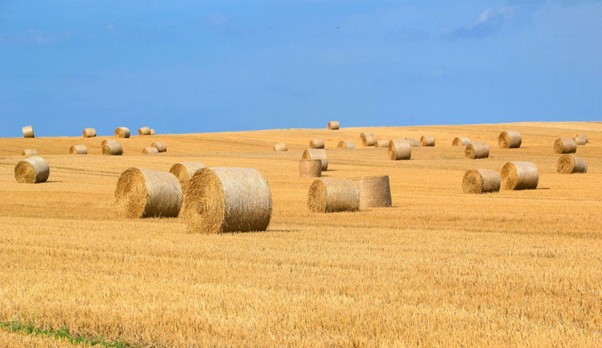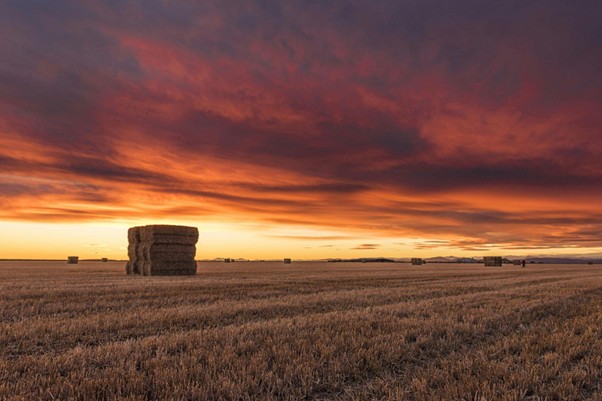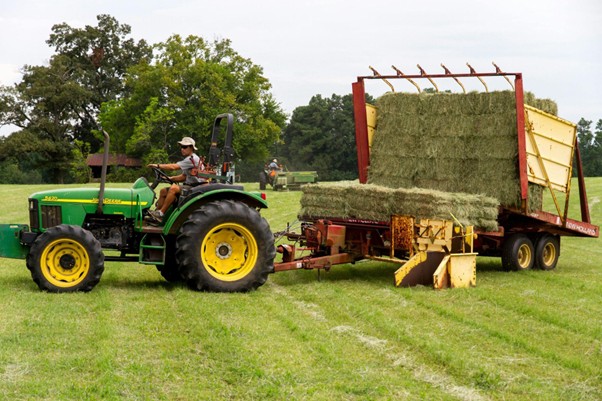
Many farmers often ask, how much does a hay bale weigh? A typical hay bale can weigh anywhere from 40 to over 1500 pounds, depending on the type and size. This tightly packed bundle of dried grass or legumes is multifunctional and serves as a vital food source and comfortable bedding for farm animals.
Knowing the average hay bale weight helps farmers manage feed supply, transport, and storage more efficiently. Proper bale management also supports accurate pricing, ensures adequate animal nutrition, and helps maintain efficient inventory control.

Hay bales come in different shapes and sizes, and their weight can vary significantly depending on the type, density, and moisture content. Understanding bale weight by type and density helps farmers choose the right bale for their feeding, storage, or transport needs.

The key factors that impact hay bale weight are:
Different crops produce hay with varying densities and moisture retention, which in turn impacts the weight of the bale. For example, alfalfa hay is typically heavier and denser than grass hay like timothy or bermudagrass.
Water is a significant component of bale weight. Hay that's baled with higher moisture levels weighs more, but excess moisture can cause mold growth or spoilage. Ideally, hay should be baled at 15–20% moisture for safe storage.
The tighter the hay is compressed, the heavier and more compact the bale becomes. Modern balers allow farmers to adjust compression settings based on handling needs.
Larger round and square bales naturally weigh more due to their volume and packing pressure. Small square bales, though lighter, are easier to handle and transport.
Over time, hay can lose moisture and slightly decrease in weight. Properly storing bales in a dry, covered area helps preserve both weight and nutritional quality.
The stage of plant growth also impacts bale weight, density, and nutritional value. As forage plants mature, they develop more stems and fewer leaves, which lowers density. For instance, immature bermudagrass hay tends to be denser and heavier than mature bermudagrass hay.
Knowing the exact weight of your hay bales helps with pricing, feed planning, and logistics. Farmers can estimate or measure bale weight using the following methods:
The most accurate way to measure bale weight is by using truck scales or portable bale scales. Simply weigh the vehicle or trailer empty, then again with the hay loaded, and subtract the difference to get the total bale weight.
You can estimate bale weight using a simple formula: Bale Weight = Volume × Density.
For this method, you must know the exact bale's dimensions and the average density of the hay type being used.
Different hay types have distinct densities that affect bale weight.
If scales aren't available, farmers can weigh a few representative bales by hand or with a small portable scale, then calculate the average weight per bale. Multiplying that number by the total bale count provides a reliable estimate for the entire load.
In the United States, one ton equals 2,000 pounds. To determine how many bales per ton, you'll need to know the average weight of each bale type.
How to Calculate?
To calculate how many bales are in a ton, use this simple formula:
Number of Bales = 2,000 ÷ Average Bale Weight
Example: If a small square bale weighs 50 lbs: 2,000 ÷ 50 = 40 bales per ton

Proper handling and storage are key to maintaining hay quality, minimizing losses, and ensuring safe transport. Here are some valuable tips for farmers and livestock owners:
Here are some common myths about hay bale weight and the truth behind them:
Fact: Not true. Bale weight varies depending on hay type, moisture level, and how tightly it's packed. Two bales with identical dimensions can differ by 20–30% in weight.
Fact: A heavier bale isn't necessarily more nutritious. Extra weight can come from excess moisture, which may cause mold or spoilage. Quality depends on forage type, maturity, and how the hay was cured.
Fact: While round bales are often larger, small and large square bales can actually be denser. Bale shape doesn't guarantee weight; it depends on density, crop variety, and compression.
Fact: Hay continues to lose moisture over time, which slightly reduces weight. Proper storage helps slow this process and maintain both bale weight and feed quality.
Fact: While experienced farmers may make close guesses, manual estimation isn't reliable. Using a scale or weight calculation formula gives far more accurate results.
Producing hay bales with the right balance of weight and nutritional quality is essential for efficient feeding and storage. Here are some proven ways to improve both:
Cut forage when it’s at early to mid-maturity. Younger plants are denser and leafier and provide higher protein and energy content.
Bale hay when the moisture content is between 15% and 20%. Managing the moisture content of the hay bale is essential. Too much moisture adds unnecessary weight and increases the risk of mold; too little causes leaf shatter and nutrient loss.
Set the baler compression and pickup speed properly to ensure uniform, tightly packed bales. Consistent density prevents weight variation and improves storage efficiency.
Gently turn and fluff hay during drying to promote even moisture loss. This keeps leaves intact and reduces dry matter loss while achieving the ideal baling moisture.
Protect hay from rain, ground moisture, and direct sunlight. Store under cover or use breathable tarps with ventilation gaps. Proper storage preserves both weight and feed quality over time.
Use forage testing to measure nutrient levels and moisture content. Keeping records helps identify what baling methods and timings produce the best results.
FarmKeep helps small farmers and homesteaders stay organized, save money, and make smarter feeding decisions with easy-to-use tracking tools.
With FarmKeep, you can:
A large square bale weighs 800–1,500 lbs (360–680 kg), and the weight of the large round bale is 1,000–1,500 lbs (450–680 kg). Large square bales are used in large-scale farming and commercial livestock feeding, while round bales are suitable for large herds and bulk storage.
The cost of a round bale of hay is anywhere between $50 and $150. It is a recurring cost, and keeping an inventory ensures you have enough feed for your livestock, prevents spoilage and waste, tracks financial costs, and manages storage space effectively.
Hay bale sizes vary by type and purpose.
The average dimensions and weight of a hay bale depend on its type:
No, hay bales are not all the same size. The round hay bale weight is different from the square hay bale weight. Their dimensions and weight vary depending on the baler type, hay variety, moisture content, and density settings.
Hay bales should be stored in a dry, covered area or on pallets outdoors with proper ventilation to prevent mold. They are transported using tractors, loaders, or trailers. The bales should be secured with straps or netting to keep them safe and stable.